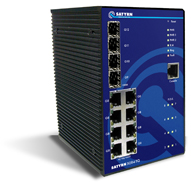The increasingly popular technology of Power over Ethernet (PoE) is now widely used in IP cameras, Voice over IP (VoIP) products and access control, writes Tony Elvidge of Comtrol (www.comtrol.co.uk).
Almost anything where you need an Ethernet connection and local power can make use of PoE. The main benefit everyone talks about is a saving on cabling costs, why have two cables, one for power and the other for data if you can use just one. However if PoE is used with a managed Ethernet PoE switch, the combination can provide a lot more.
What is Power over Ethernet?
Power over Ethernet is sending power to a device (IP camera, access point, RFID reader, etc) over an Ethernet cable rather than having a separate power cable. In 10/100 systems data is sent down two of the pairs of wires in an Ethernet cable and power down the other two pairs. With Gigabit the power is superimposed on the data as Gigabit uses all four pairs of wires. The power and data do not interfere with one another. Those familiar with the audio world this is similar to phantom power used to power microphones.
PoE is usually set up via a power injector (a passive device that takes in data only Ethernet and adds the power) or a PoE switch with one or more ports with power added. Two standards are available for Power over Ethernet, 802.3af (up to 15.4 watts/port) and 802.3at (up to 30 watts/port), known as PoE+. There are plans to increase the power available further to 60-80 watts (PoE Ultra or PoE ++) and even to 95 watts (PoE Mega). Don’t forget that these figures are quoted at the switch/injector port and up to 20 per cent could be lost on a long cable run. Some switches-injectors cannot provide full power across all ports and there is a quoted limit on the total power available; the power budget. You will need to take this into account when constructing a system as this could limit the number of devices that can be accommodated on each switch.
Benefits of a managed switch over a power injector
While an unmanaged PoE switch or a power injector can provide the power to the remote device a managed PoE switch can provide so much more. For example a managed PoE switch such as one from Comtrol’s Satyrn L, M or X range can send a regular ‘ping’ to the remote device and monitor the return message. So in effect the switch is sending an ‘are you still there?’ message and the end device is replying ‘Yes I am’.
If the switch does not get a reply to the ‘ping’ (the number of retries can be set in the switch), it can do a number of things, all of which can be set in the switch. In its simplest form it can send someone an e-mail, it can set up an SNMP alert or make an entry into a Syslog system. The most likely response though is that the powered device would be automatically rebooted. All of this can be done without anyone going out to check the device. Also, if the Syslog entries are fed into a preventative maintenance system then devices that need rebooting on a regular basis a service can be investigated.
Many managed PoE switches can set a power sequence for each of its ports. This enables the power to be made available to the end devices only when it is needed. This can save considerable power as the camera, access point or lighting will only be switched on when it is needed.
Most managed PoE switches make use of the Link Layer Discovery Protocol (LLDP). This can be used by the switch to find out details of the devices on the network it is linked to and then communicate with them to, for example, dynamically allocate power to the appropriate switch port and on to the powered device. So for example if a camera with built in lighting requires extra power for the lights during the hours of darkness, the switch can provide that additional power.
A number of switches, including the Satyrn range, boost the power available under 802.3af to 25 watts thus making more power available to the end device; increasingly important as power hungry products are brought on to the market. Equally a PoE powered wireless mesh or point to point radio with a lower power draw can be allocated less power making more of the switch’s power budget available to other devices. This approach can even be used to put the device into sleep mode when appropriate.
A number of the switches have a built in power converters that enable the switches to power 48VDC or 50VDC PoE or PoE+ units from a 12-36VDC external power supply. This makes them ideal for use in vehicles.
All of the Satyrn managed PoE switches have dual or triple redundant power supplies so that in the event of a power failure on one supply the changeover to the alternative supply can happen in fractions of a second, ensuring continuity of service.
Conclusion
PoE with a managed switch is much more than just saving on wiring costs. It can give you a lot more control over the operation of the powered device and regular, reliable warning of potential problems.
Look out for further articles in this series covering VLANs/Quality of Service, Redundancy, Security, and more. These will never be the definitive technical article on the different subjects, but will be an overview of the area for those who are looking for a guide in plain English but don’t have the time, or inclination, to research the technology in depth.










